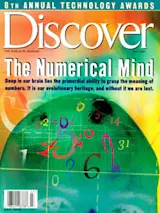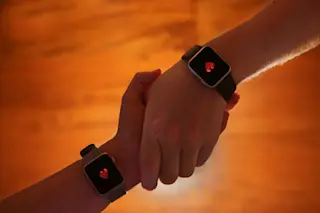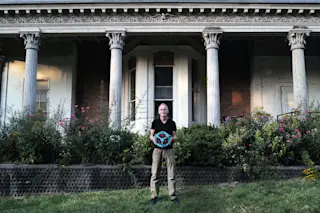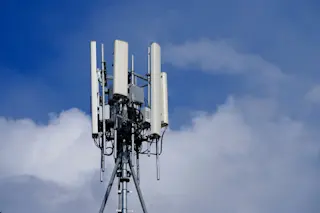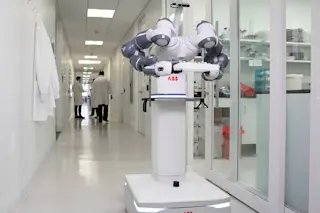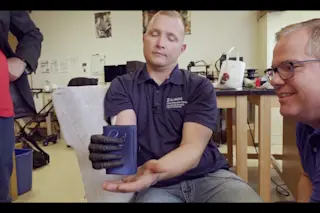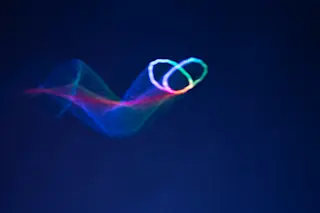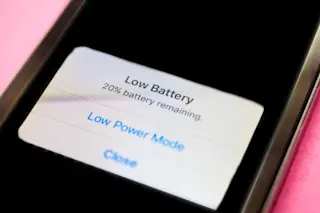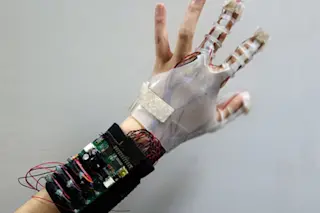WINNER: NASA Langley’s Fiber-optic Strain Sensor
INNOVATOR: Mark Froggatt
Engineers follow a simple rule for avoiding disasters: Build things stronger than they need to be. That works pretty well with bridges and dams, where a little extra concrete never hurts, but aerospace technologist Mark Froggatt knew it was not appropriate for the space shuttle, where every ounce counts. He also knew NASA wanted an alternative to its current practice of essentially ripping the shuttle apart after each flight to look for parts failing under the enormous stresses of spaceflight.
So Froggatt and his colleagues at NASA Langley Research Center in Hampton, Virginia, built an early-warning device that provides detailed information about even minuscule cracks and deformations, allowing engineers to get away with a narrower margin of safety when building airplanes and spaceships. It’s a five-thousandths-of-an-inch-thick fiber- optic cable, and along every foot of its length Froggatt writes a group of tiny lines--called a grating--with ultraviolet light. Then he glues the fiber to the side of a part, such as a fuel tank, and shines a laser beam down the fiber. From the reflected light, he can tell which gratings are under stress.
When Froggatt started out, he knew only that he could design a grating to reflect light of a particular frequency and that if the grating were put under stress, it would let the same light pass while reflecting light of a slightly different frequency. Unfortunately, designing each grating to reflect a different frequency would have been impractical. But how else could he differentiate among the tens or hundreds of gratings along a single fiber? Other engineers said it couldn’t be done, but Froggatt, an electrical engineer by training, got inspiration from his television set. Just as a tv picks out one channel from dozens being broadcast at any one time, he realized, he could distinguish the light reflected by each individual grating even if they were all designed to reflect the same frequency. Since the light has to travel a little farther to each successive grating and back again, he could tell, by measuring where the peaks and troughs of the reflected light waves lined up, which gratings were reflecting light, and which--because of stress, strain, and deformation--were not.
According to Froggatt, if the space shuttle had been built with the fiber-optic strain sensors, problems could be located and fixed in hours instead of weeks. nasa wants the X-33, the next-generation shuttle, to be a bus, he says, something they could land and launch the next day. It needs to be able to examine itself. The sensor was tested on a prototype X-33’s fuel tank in January 1997, but the real test will come when the shuttle takes to the skies in 1999. If it works, airplanes are the next likely targets, and after that, maybe even bridges.
Finalists
Light Catcher
NASA Goddard Space Flight Center’s Space Telescope Imaging Spectrograph
INNOVATOR: Bruce Woodgate
Fourteen years ago Bruce Woodgate started working on a device to detect and analyze light from distant, faint stars and galaxies, even though the orbiting space telescope to which it needed to be attached had not yet been launched. Last February the gloved hands of an astronaut finally installed Woodgate’s device in the Hubble Space Telescope.
Not that Woodgate, a research scientist at nasa’s Goddard Space Flight Center in Greenbelt, Maryland, and his colleagues didn’t have enough to keep them busy all these years. The Hubble was originally equipped with a spectrometer that could see only a narrow range of frequencies and one small spot of the sky at a time. nasa, however, wanted it to pick up a wider range of frequencies and a true two-dimensional image of a patch of sky. The researchers’ first challenge was to find a way to capture the sparse stream of photons--particles of light--that make it across the universe from distant celestial objects and convert the captured light into an image. To collect photons of ultraviolet light, Woodgate and his group designed a detector that incorporates a bundle of 3 million microscopically thin tubes. When a photon arrives at the detector, it sends an electron careering down a tube like a bobsled, knocking still other electrons from the tube’s wall. By the time it emerges through the other end, it has freed up a million of its brethren, which together make an electronic signal strong enough to be detected. And since the tubes keep the electrons in an orderly, two-dimensional arrangement, it’s easy to use the signals to construct an image.
Woodgate and his colleagues also needed to develop ultrasensitive electronic devices for detecting the meager amounts of visible-light photons that reach the telescope. Then they put everything on a single chip. We had solved a lot of the problems individually over the years, says Woodgate. The main challenge was to make detectors for visible and ultraviolet light that are both sensitive and rugged enough for use in space. A version of the chip is also being used in mammography, where its sensitivity allows doctors to use weaker X-rays while finding tumors more precisely.
Microwavable Rocket
Penn State University’s Microwave
Arcjet Thruster
INNOVATOR: Michael Micci
When Michael Micci set out to build a better rocket, he went straight to the kitchen, but not for a comfort snack. He was scrounging for parts, and he found what he needed in a microwave oven.
Micci, an aerospace engineer at Penn State, had been mulling over the problem of how to endow satellites with cheap, long-lasting rocket thrusters to keep themselves from drifting. Many satellites now use electricity to zap an ordinary gas, such as ammonia, which sends its atoms flying out the back and pushes the satellite forward. These engines are cheap, but the hot gas eats away at the electrodes, eventually rendering the engine useless.
Micci thought of zapping the gas with microwaves rather than electricity back in the 1980s. nasa had looked at using microwaves and concluded that it wouldn’t work, Micci says, but I thought I could make it work. He came up with a design that uses the same 1,000-watt electrically powered oscillating magnet that causes water molecules in a potato to vibrate in a conventional microwave oven, thus cooking it. Except that Micci’s magnet heats the gas fuel, not potatoes, and it focuses its power into one very hot spot in the gas rather than trying to heat the gas evenly. Temperatures and pressures get so high in the hot spot--up to 21,000 degrees--that atoms of gas shoot out the rear nozzle.
Micci tested his engine, the Microwave Arcjet Thruster, in the lab last summer. He thinks the engine will find a market in communications satellites such as those used to broadcast television signals. Research Support Instruments, an aerospace firm in Lanham, Maryland, wants to build the thrusters, and Micci is looking for satellite manufacturers interested in using them.
A Keck for Less
University of Texas at Austin and Penn State University’s Hobby- Eberly Telescope
INNOVATORs: Thomas Sebring and Lawrence Ramsey
When the University of Texas at Austin asked optics engineer Thomas Sebring and astrophysicist Lawrence Ramsey, of Penn State University, to build a giant, state-of-the-art telescope similar to the one at the Keck Observatory in Hawaii, they knew they faced a challenge. After all, the Keck has hundreds of custom-built components, including dozens of small mirrors of six different shapes, each ground to perfection with custom-built equipment and held in place by a rigid framework to extraordinarily precise tolerances. But when Sebring and Ramsey were told their budget was one-seventh the amount of Keck’s, the challenge became more like an impossible mission.
Sebring, however, had worked for seven years as an engineer with the government’s Strategic Defense Initiative--also known as Star Wars-- just as its big cold-war budget was coming to a close, so he’d learned nothing if not how to cut corners. His and Ramsey’s strategy for the new telescope was simple: pore over blueprints for the Keck and search for ways to substitute cheaper, off-the-shelf parts. It was immediately clear we couldn’t follow the Keck’s approaches, Sebring says, so we spent a lot of time brainstorming.
Their first grand idea was to cut costs by making the telescope’s mirror curve like a sphere rather than the parabola typical of other telescopes. Although the spherical shape causes the image quality to suffer slightly, it has no effect on spectroscopic measurements, which is what the telescope was primarily intended to do. And it meant that each of the 91 mirror segments could be precisely the same three-foot-wide hexagon. The researchers also did away with an expensive support structure that would hold each mirror segment firmly to withstand gravity’s warping pull; they decided instead to use a relatively inexpensive frame and let gravity do its worst. Then, to compensate for the distorting effects of gravity, they mounted the telescope at a permanent 55-degree angle to the horizon. That way, they knew precisely what position each mirror segment would have relative to Earth, and so they could grind each segment in such a way that it assumed a perfectly spherical shape only after it was installed in the frame and gravity caused it to sag. A small motor behind each segment tilts it to keep the chosen celestial target in focus. (And rather than custom- building motors for aiming the mirrors, they used tiny motors made for focusing microscopes.) Of course, the fixed angle of the telescope prevents astronomers from seeing anything very close to the horizon or directly overhead, but by allowing the telescope to swivel 360 degrees, they can still take in 70 percent of the sky.
The completed telescope is expected to produce its first images this month--on time and within budget. Sebring and Ramsey, though, won’t have much time to catch their breath. We’re getting a lot of calls from other telescope projects to find out how we did it, Sebring says.


